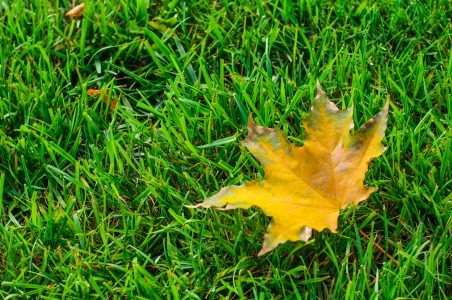Garden Variety: Lay the groundwork now for a healthy lawn

photo by: Shutterstock
Late fall is the time to fertilize the lawn for cool-season grasses.
For fescue and bluegrass lawns, late fall is one of the most important times to provide extra maintenance in the form of fertilizer.
Fertilizer is needed at least occasionally to keep lawn grasses healthy in most soils. Healthy lawns reduce soil erosion and stormwater runoff. They outcompete weeds, are better able to withstand pests and require less maintenance than many other options. Gardeners who are concerned about synthetic fertilizers may choose organic fertilizers.
The reason the late fall application is so effective is that at this time of year, plants are storing nutrients and energy in their roots for use in the spring. Nutrients from the fertilizer are taken up by the plant and stored, enhancing root growth and allowing plants to green up more quickly in the spring than they would otherwise. The green color is from the presence of chlorophyll, which is necessary for photosynthesis.
Make fall fertilizer applications in mid-November to early December when plant growth slows.
Select a fertilizer that is quick-release, has a high nitrogen content and has low amounts of phosphorus and potassium unless a soil test has indicated those nutrients are needed. Whether a fertilizer is quick-release or slow-release should be identified on the label. The nitrogen, phosphorus and potassium amounts will also be indicated on the label in the form of three numbers separated by hyphens. For example, a fertilizer labeled 27-3-3 contains 27% nitrogen, 3% phosphorus and 3% potassium. Percentages are calculated by weight.
Nitrogen is necessary for plant growth. It is used in large amounts by plants, but it sometimes is tied up in the soil or atmosphere and unavailable to the plant. Phosphorus and potassium are used in lower amounts by plants and are often plentiful in soils in the Lawrence area.
Read and follow label directions for application rates and methods, or hire a lawn care professional to apply the fall fertilizer. Be sure to sweep or blow any fertilizer that lands on hard surfaces, such as a sidewalk, back onto the lawn at the end of the application. This prevents the nutrients from being wasted and washing away into stormwater.
The difference between synthetic, organic and hybrid fertilizers is negligible to plants, so which one you use is a matter of preference and price.
Synthetic fertilizers are manufactured, and there may be environmental concerns associated with their production. They often also contain salts that build up in the soil over time with continued use. Organic fertilizers are derived from natural materials such as plant and animal waste. Organic fertilizers with high nutrient contents can be hard to find, but they have an added benefit of improving other aspects of soil health, which also contributes to better plant health. Hybrid fertilizers are a cross between the two. They attempt to provide higher nutrient contents as well as organic matter for overall soil health.
Synthetic fertilizers are typically the least expensive because they are more easily produced. Comparing the true costs of different types of fertilizer is difficult, though — it requires a lot of math with those nitrogen percentages in comparison to the size of the bag. Also, the improved soil health associated with organics and hybrids can make existing soil nutrients more available to the plants growing there.
Spring fertilization of fescue and bluegrass lawns is less effective than fall fertilization because plants are putting energy into top growth in the spring. They take up the fertilizer and put all of it into lush growth that requires more mowing than it would otherwise. If root systems are not adequate, these lawns will also be less tolerant of heat and drought when the weather warms. The only exception is for irrigated lawns, which may benefit from fertilization in May.
Fescue and bluegrass are grouped together as cool-season lawn grasses. Perennial ryegrass is another cool-season grass that benefits from late fertilization and may be a familiar name. Perennial ryegrass does not perform well in Kansas because of its disease susceptibility, and it is not recommended. Bermudagrass, buffalograss and zoysiagrass are warm-season lawn grasses that perform well in Kansas but have lower nutrient requirements than fescue and bluegrass and should be fertilized when actively growing in the summer (if at all).
— Jennifer Smith works in regulatory horticulture and has worked as a horticulturist for various government entities. She has experience in landscape design and maintenance and as an educator.

